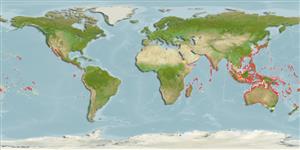Gastropoda |
Nudibranchia |
Gymnodorididae
Environment: milieu / climate zone / depth range / distribution range
Ecology
Benthic; depth range 0 - 30 m (Ref. 7727). Tropical
Indo-Pacific.
Length at first maturity / Size / Weight / Age
Maturity: Lm ? range ? - ? cm
White with orange spots and usually an orange border reaching the pointed head region of the mantle. Gills are translucent white, having an orange line along the outer axis of the upper half of each gill. The translucent white rhinophore club is tipped with orange. Posterior end of the foot is either tipped with orange or has an orange median line.
Inhabits coral rubble at depths of 1 to 2 m (Ref. 866). Observed feeding on aeolid nudibranchs (Ref. 79924).
Life cycle and mating behavior
Maturity | Reproduction | Spawning | Eggs | Fecundity | Larvae
Members of the order Nudibranchia are simultaneous hermaphrodites. Mating behavior: Both individuals darts their penis toward each other to induce one to act as a male and the other as the female. The victorious one to penetrate the body wall is the dominant male. Life cycle: Eggs are deposited on a substratum where they develop and hatch into (planktonic) vestigial veliger larval stage and further grow as adults.
Gosliner, T. 1987 Nudibranchs of Southern Arfrica: A guide to opistobranch molluscs of Southern Africa. Sea Challengers and Jeff Hamann in association with the California Academy of Sciences. 136 pp. (Ref. 866)
IUCN Red List Status
(Ref. 130435: Version 2025-1)
CITES status (Ref. 108899)
Not Evaluated
Not Evaluated
Threat to humans
Harmless
Human uses
| FishSource |
Tools
More information
Trophic EcologyFood items (preys)
Diet composition
Food consumption
Predators
Population dynamicsGrowth
Max. ages / sizes
Length-weight rel.
Length-length rel.
Length-frequencies
Mass conversion
Abundance
Life cycleReproductionMaturityFecunditySpawningEggsEgg developmentLarvae PhysiologyOxygen consumption
Human RelatedStamps, coins, misc.
Internet sources
Estimates based on models
Preferred temperature
(Ref.
115969): 18.3 - 29.2, mean 28 (based on 4105 cells).
Price category
Unknown.
